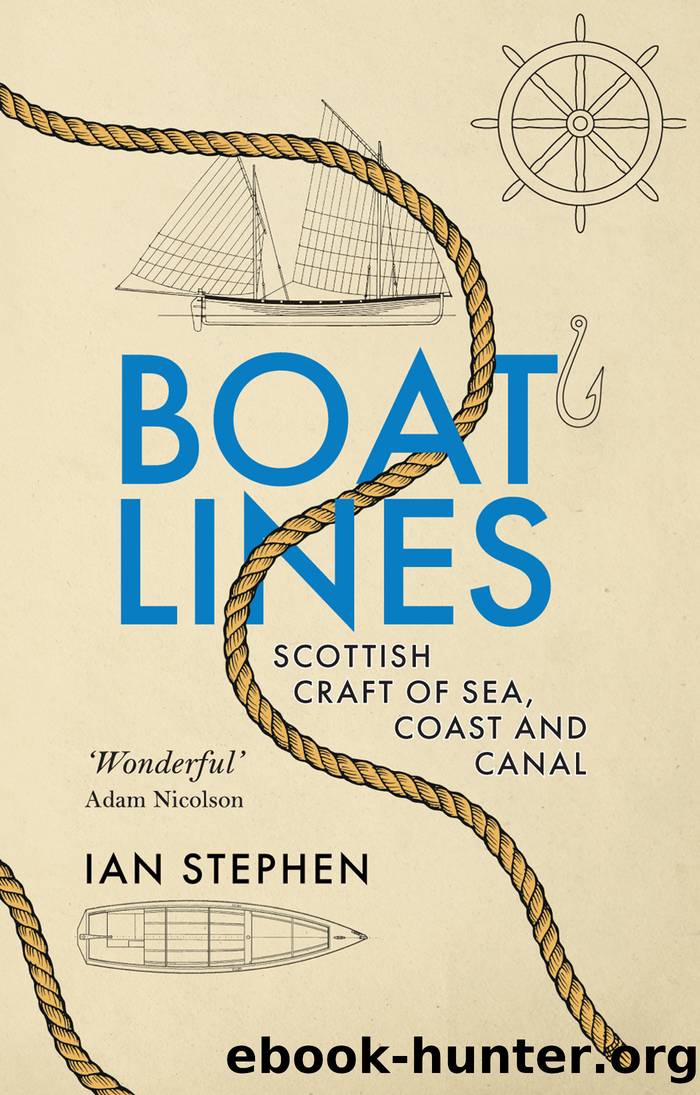Boatlines by Ian Stephen

Author:Ian Stephen [Stephen, Ian]
Language: eng
Format: epub
Publisher: Birlinn
NOTES
(1) Part of the P.J. Oke collection. Plans can be viewed at Royal Museums Greenwich. Catalogue reference: https://www.rmg.co.uk/collections/objects/rmgc-object-388638. See also list of references to articles on vessels, including references to the work of P.J. Oke: https://snr.org.uk/wp-content/uploads/2018/05/Topmasts-26-Supplement.pdf.
21
THE CURACH â A SKIN ON TIMBER BONES
WHEN IT COMES TO BOATS, it seems to me there are two main ways of doing it. You can build a frame, then stretch a skin around it. The other way is to lay planks from the keel up, overlapping, to form a shell. The curach is of the first type. Both the Portpatrick line boat and the Drontheim are examples of the second.
The curach is usually thought of as an Irish craft where the spelling is normally curagh, curragh or currach. As we are concerned with vessels linked to Scottish coasts here, the most usual Scottish Gaelic version of the name will be used from now on. Examples of the craft survived in areas of Ireland, especially the Atlantic islands of Aran and Blasket, at a time when more modern (and more expensive) solutions were adopted in most places. However, accounts of voyaging monks reveal that the vessel was central to communications between Ireland and Scotland, including the founding of monasteries such as Iona. Even the most distant monastic settlements out at Flannan Isles or North Rona must have been reached by seagoing versions of these skin boats. Alistair Moffatâs In Search of Angels maps the routes and imagines the settlements and culture of these voyagers in an early Scotland.1
These were vessels of skin, but something has to give a craft a shape. Think of a lattice of light and flexible woods, lashed into compression. An overlaid material is stretched to cover that. Then that outer surface is proofed with fat or oil, tar or some other concoction, till it glistens. Materials were available or relatively cheap. The craft also had the advantage that it could be simply upturned and carried on the shoulders of her rowers, to safety up from the tides. The complementary disadvantage is that the light skin is vulnerable. If that is caught by a rock or chafed in abrasive sand, it will rip. The skin boats used to run tideways and ocean currents must have been robust, as recreated in Tim Severinâs inspiring project to test if the âstepping stonesâ route through the Hebrides and on to the Faroes, Iceland and the Labrador coast in Brendan was feasible in an oxhide craft. Smaller and lighter curach were in general use on routes between Scottish islands but we owe this knowledge to folklore and composed verses rather than archaeology. Materials did not favour the chances of long-term survival if the form was not renewed.
So we have to look down the ebbing tide to see and experience handed-down forms of the curach. Accounts of life on the Blasket Islands reveal the centrality of this type of vessel to the communities of Atlantic Ireland. Tomás OâCrohanâs The Islandman was written in Gaelic and published in 1929 but available in English translation since 1934.
Download
This site does not store any files on its server. We only index and link to content provided by other sites. Please contact the content providers to delete copyright contents if any and email us, we'll remove relevant links or contents immediately.
Life 3.0: Being Human in the Age of Artificial Intelligence by Tegmark Max(5474)
The Sports Rules Book by Human Kinetics(4294)
The Age of Surveillance Capitalism by Shoshana Zuboff(4210)
ACT Math For Dummies by Zegarelli Mark(3994)
Unlabel: Selling You Without Selling Out by Marc Ecko(3589)
Blood, Sweat, and Pixels by Jason Schreier(3566)
Hidden Persuasion: 33 psychological influence techniques in advertising by Marc Andrews & Matthijs van Leeuwen & Rick van Baaren(3472)
The Pixar Touch by David A. Price(3364)
Bad Pharma by Ben Goldacre(3357)
Urban Outlaw by Magnus Walker(3342)
Project Animal Farm: An Accidental Journey into the Secret World of Farming and the Truth About Our Food by Sonia Faruqi(3177)
Kitchen confidential by Anthony Bourdain(3009)
Brotopia by Emily Chang(3001)
Slugfest by Reed Tucker(2942)
The Content Trap by Bharat Anand(2860)
The Airbnb Story by Leigh Gallagher(2799)
Coffee for One by KJ Fallon(2566)
Smuggler's Cove: Exotic Cocktails, Rum, and the Cult of Tiki by Martin Cate & Rebecca Cate(2471)
Beer is proof God loves us by Charles W. Bamforth(2371)
